Battle of Heligoland (1849)
The first Battle of Heligoland took place on 4 June 1849 during the First Schleswig War and pitted the fledgling Reichsflotte (Imperial Fleet) against the Royal Danish Navy, which had blocked German naval trade in North Sea and Baltic Sea since early 1848. The outcome was inconclusive, with no casualties, and the blockade went on. It remained the only battle of the German fleet.[1][2]
| Battle of Heligoland | |||||||
|---|---|---|---|---|---|---|---|
| Part of the First War of Schleswig | |||||||
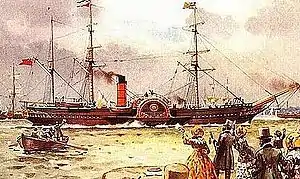 RMS Britannia before being converted to SMS Barbarossa, Brommy's flagship | |||||||
| |||||||
| Belligerents | |||||||
|
|
| ||||||
| Commanders and leaders | |||||||
|
Andreas Polder Jørgen P. F. Wulff | Karl Rudolf Brommy | ||||||
| Strength | |||||||
|
1 sail corvette 1 steamer |
1 steam frigate 2 steam corvettes | ||||||
| Casualties and losses | |||||||
| none | none | ||||||
The events
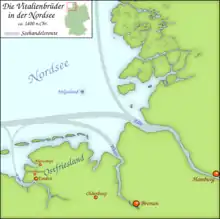
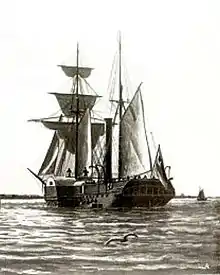
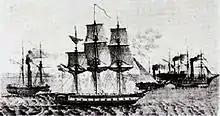
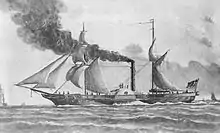
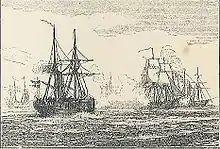
At the outbreak of the First Schleswig War, the Danes instituted a blockade, stopping all German trade in the North Sea and the Baltic Sea. This prompted the German parliament at Frankfurt to form a new all-German navy. The Germans had to build a fleet from scratch, buying ships abroad and converting them, and hiring foreign officers (British, Belgian) to lead native veteran merchant mariners.[3]
After about a year of preparation, on 4 June, German Admiral Karl Rudolf Brommy left Bremerhaven with the steam frigate SMS Barbarossa (formerly RMS Britannia) and the smaller steam corvettes Lübeck (1844) and Hamburg (1841) in order to disperse the Danish ships which were guarding the mouth of Weser River. The Danish forces present that day were inferior and retreated, but Brommy managed to cut off[3] the sailing corvette Valkyrien which under captain Andreas Polder sought refuge near the island of Heligoland which at the time belonged to the United Kingdom. The British, while being neutral, had made clear beforehand that a German Navy was not welcome and might be treated as pirates.
Ships of both sides fired some shots, with no effect. When the German approached the island's three-mile zone, the British forces fired warning shots towards them, while allowing the Danish corvette to stay close. Brommy, not willing to draw the Royal Navy into the war, stayed at a distance while the Danish captain Polder was waiting for the arrival of reinforcements from the Danish main fleet. When the modern steamer Gejser, under Kaptajnløjtnant (captain lieutenant) Jørgen Peter Frederik Wulff, came into sight, Brommy retreated, fearing further Danish reinforcements. The Danes followed the Germans to the mouth of the Elbe near Cuxhaven before resuming the blockade.
It was the first and the last excursion of the small fleet under the black-red-gold Flag of Germany.
See also
Notes
- Im Juni 1849 kam es bei Helgoland zum einzigen Gefecht der, trotz des großen materiellen Aufwandes, niemals voll einsatzfähigen Bundesflotte gegen dänische Schiffe.- Deutsche Marine, History
- die erste und einzige Seefahrt unter der Schwarz-rot-goldnen Flagge – Georg Wislicenus, Deutschlands Seemacht
- Lawrence Sondhaus, Naval Warfare, 1815–1914 p. 49
Literature
- Guntram Schulze-Wegener: Deutschland zur See . 150 Jahre Marinegeschichte. Mittler, Hamburg 1998. ISBN 3-8132-0551-7
- Jörg Duppler : Germania auf dem Meere / Bilder und Dokumente zur Deutschen Marinegeschichte 1848 –1998. Mittler, Hamburg 1998. ISBN 3-8132-0564-9
- Giese, Fritz: Kleine Geschichte der deutschen Flotte
- Hansen, Hans Jürgen: Die Schiffe der deutschen Flotten 1848–1945
- Hildebrand, Hans H. / Henriot, Ernest:: Deutschlands Admirale 1849–1945
- Kroschel, Günter / Evers, August-Ludwig: Die deutsche Flotte 1848–1945
- Rhades, Dr. Jürgen: Die deutsche Marine in Vergangenheit und Gegenwart
- Röhr, Albert: Deutsche Marinechronik
- Witthöft, Hans Jürgen: Lexikon zur deutschen Marinegeschichte
- Georg Wislicenus: Deutschlands Seemacht, Published 2007 Reprint-Verlag-Leipzig, 206 pages, ISBN 3-8262-2313-6
- Lawrence Sondhaus: Naval Warfare, 1815–1914, Published 2001, Routledge, 272 pages, ISBN 9780415214780
External links
- Deutsche Marine, History (in German)
- Überblick über die Reichsflotte (in German)
